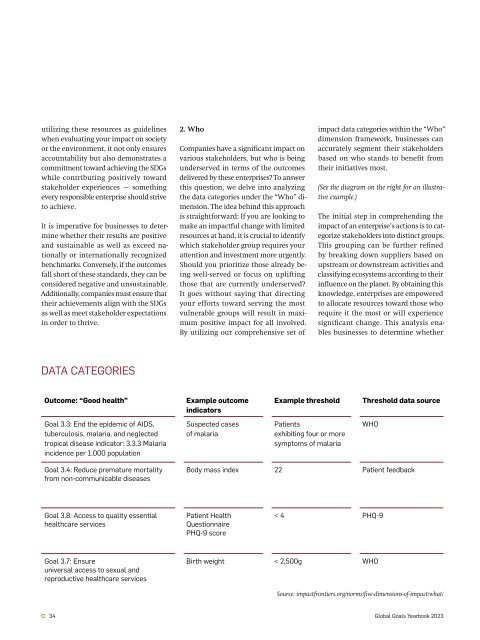Global Goals Yearbook 2023 makes SDG impact measurable
No poverty, no hunger, peace: In 2015, the United Nations adopted the 17 Sustainable Development Goals, which were supposed to make the world a better place by 2030. Now it is half-time. The results are sobering. In the remaining time, measures must be more targeted and more effective. On the occasion of COP28 in Dubai, the Global Goals Yearbook is focusing on the aspect of impact.
No poverty, no hunger, peace: In 2015, the United Nations adopted the 17 Sustainable Development Goals, which were supposed to make the world a better place by 2030. Now it is half-time. The results are sobering. In the remaining time, measures must be more targeted and more effective. On the occasion of COP28 in Dubai, the Global Goals Yearbook is focusing on the aspect of impact.
Create successful ePaper yourself
Turn your PDF publications into a flip-book with our unique Google optimized e-Paper software.
utilizing these resources as guidelines<br />
when evaluating your <strong>impact</strong> on society<br />
or the environment, it not only ensures<br />
accountability but also demonstrates a<br />
commitment toward achieving the <strong>SDG</strong>s<br />
while contributing positively toward<br />
stakeholder experiences – something<br />
every responsible enterprise should strive<br />
to achieve.<br />
It is imperative for businesses to determine<br />
whether their results are positive<br />
and sustainable as well as exceed nationally<br />
or internationally recognized<br />
benchmarks. Conversely, if the outcomes<br />
fall short of these standards, they can be<br />
considered negative and unsustainable.<br />
Additionally, companies must ensure that<br />
their achievements align with the <strong>SDG</strong>s<br />
as well as meet stakeholder expectations<br />
in order to thrive.<br />
2. Who<br />
Companies have a significant <strong>impact</strong> on<br />
various stakeholders, but who is being<br />
underserved in terms of the outcomes<br />
delivered by these enterprises? To answer<br />
this question, we delve into analyzing<br />
the data categories under the “Who” dimension.<br />
The idea behind this approach<br />
is straightforward: If you are looking to<br />
make an <strong>impact</strong>ful change with limited<br />
resources at hand, it is crucial to identify<br />
which stakeholder group requires your<br />
attention and investment more urgently.<br />
Should you prioritize those already being<br />
well-served or focus on uplifting<br />
those that are currently underserved?<br />
It goes without saying that directing<br />
your efforts toward serving the most<br />
vulnerable groups will result in maximum<br />
positive <strong>impact</strong> for all involved.<br />
By utilizing our comprehensive set of<br />
<strong>impact</strong> data categories within the “Who”<br />
dimension framework, businesses can<br />
accurately segment their stakeholders<br />
based on who stands to benefit from<br />
their initiatives most.<br />
(See the diagram on the right for an illustrative<br />
example.)<br />
The initial step in comprehending the<br />
<strong>impact</strong> of an enterprise’s actions is to categorize<br />
stakeholders into distinct groups.<br />
This grouping can be further refined<br />
by breaking down suppliers based on<br />
upstream or downstream activities and<br />
classifying ecosystems according to their<br />
influence on the planet. By obtaining this<br />
knowledge, enterprises are empowered<br />
to allocate resources toward those who<br />
require it the most or will experience<br />
significant change. This analysis enables<br />
businesses to determine whether<br />
DATA CATEGORIES<br />
Outcome: “Good health”<br />
Example outcome<br />
indicators<br />
Example threshold<br />
Threshold data source<br />
Goal 3.3: End the epidemic of AIDS,<br />
tuberculosis, malaria, and neglected<br />
tropical disease indicator: 3.3.3 Malaria<br />
incidence per 1,000 population<br />
Suspected cases<br />
of malaria<br />
Patients<br />
exhibiting four or more<br />
symptoms of malaria<br />
WHO<br />
Goal 3.4: Reduce premature mortality<br />
from non-communicable diseases<br />
Body mass index 22 Patient feedback<br />
Goal 3.8: Access to quality essential<br />
healthcare services<br />
Patient Health<br />
Questionnaire<br />
PHQ-9 score<br />
< 4 PHQ-9<br />
Goal 3.7: Ensure<br />
universal access to sexual and<br />
reproductive healthcare services<br />
Birth weight < 2,500g WHO<br />
Source: <strong>impact</strong>frontiers.org/norms/five-dimensions-of-<strong>impact</strong>/what/<br />
34 <strong>Global</strong> <strong>Goals</strong> <strong>Yearbook</strong> <strong>2023</strong>
















